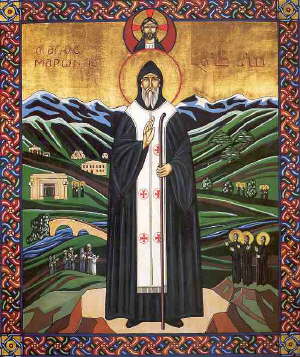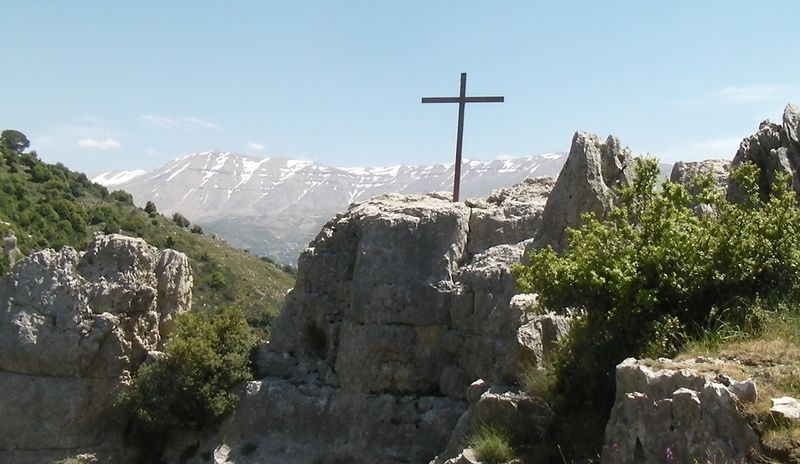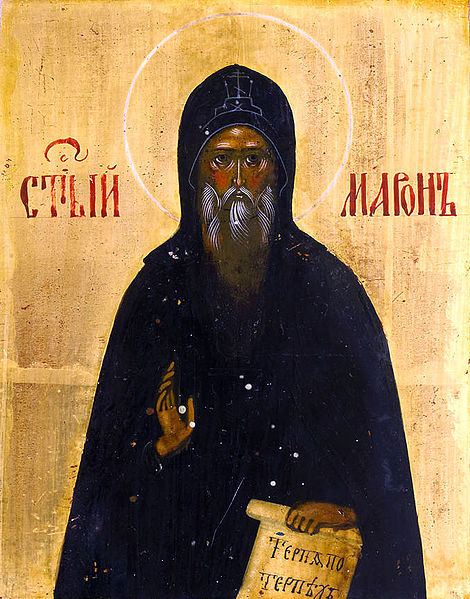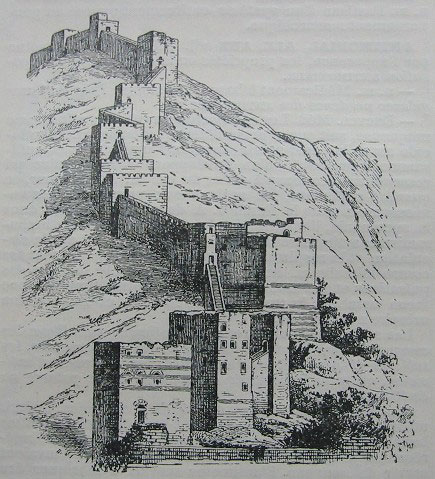St. John Maron
 Origin of St. John Maron
Origin of St. John Maron
John Maron was born in Sarum, a prosperous town located south of the city of Antioch. His date of birth is not mentioned but many historians place it around the third decade of the seventh century. He descended from a Frankish royal family which governed Antioch, a cosmopolitan city, that attracted professionals in all areas of expertise from both Europe and all parts of the Byzantine Empire. His parents were Agathon and Anohamia, and Prince Alidipas, his paternal Grandfather, was the nephew of Carloman, a Frankish Prince. He was called John the Sarumite in relation to Sarum where Agathon his father was governor.
John’s early schooling was in Antioch. He continued his higher learning at the Monastery of St. Maron where he mastered mathematics, sciences, philosophy, theology, linguistics and Sacred Scripture. It was at the Monastery of St. Maron where he professed his monastic vows and was ordained to the priesthood. Adopting a monastic name as was the tradition, he chose the name of the Monastery, thus the name John Maron.
John Maron went to Constantinople where he learned Greek and studied patrology and its spirituality. After his father’s death, he returned to the Monastery of St. Maron where he distinguished himself by becoming a prolific writer covering a wide variety of fields. His writing ranged from pedagogy, to the art of speech, to the sacraments, to Church property and legislation. He updated the Book of Ordination and redefined liturgical ceremonies. Later he composed a special Anaphora (Eucharistic Prayer) which bears his name “The Anaphora of St. John Maron Patriarch of Antioch” and is still in use to the present time. He taught and preached the dogma of the Catholic Church according to the Council of Chalcedon, which proclaimed that in Christ there are two natures human and divine. He compiled a series of letters in which he encouraged the faithful to adopt this sacred dogma and admonished them to reject the teaching of the Monophysite and the Monothelite heresies. The former claimed that there is one Nature in Christ, while the latter clung to the one Will in Christ.
Bishop
As a young priest he engaged himself in ecumenical debates with the Monophysites. He traveled all over Syria and around Antioch where he lectured and defended the Chalcedonian Dogma. He visited parishes and monasteries explaining the Divine and the Human Natures in Christ. He strengthened the Chalcedonians, urging them to remain loyal to the teaching of the Catholic Church, in spite of the fact that they were a minority among infidels and Moslems. His attractive style of teaching and his convincing method of argumentation converted many Monophysites and Monothelites to the Maronite fold and brought many non-believers to embrace the Catholic faith.
Lebanon
Such a treasure could not have been hidden for long. John Maron’s spiritual zeal, his loyalty to Catholic teaching, his caring for the needy and his leadership led him to a special calling whereby he would serve the church on a loftier level. Prince Eugene of France, with his French colony in Antioch urged the Apostolic Delegate to consecrate John Maron a bishop so as to perpetuate the teaching of the Council of Chalcedon and to protect the Church from the attacks of heretics. But the Holy See had different plans for this educated and charismatic leader and cleric. The rapid Arab expansion and the constant attacks of the Monophysites jeopardized the presence of the Catholic Church in Mount Lebanon. Being aware of the leadership of John Maron and his Maradite army, the Holy See felt that John Maron would be the right leader to face the Arabs, to challenge the Monophysites, and to keep the Maronites united with the Church of Rome. John Maron was consecrated a bishop in 676A.D. He was sent to Mount Lebanon for this special purpose.
 The fighting between Abd-Al-Malik and Ibn-Al-Zubeir over the succession of the Umayyad dynasty took a toll on the people of the area, causing unemployment and inflation in the land. Add to that the famine and the plague which overwhelmed the population and destroyed a great number of the inhabitants in the region. During these difficult and trying times, Bishop John Maron tended to his flock, traveled between towns and villages, consoled the oppressed, sheltered the homeless and fed the hungry. Just like his master St. Maron, God had endowed him with a special gift of healing. John Maron would anoint the plagued and pray over the terminally ill and they would immediately be healed. In addition to being a compassionate healer, an excellent teacher and an effective preacher, he was also a respected political figure and an outstanding leader of his community.
The fighting between Abd-Al-Malik and Ibn-Al-Zubeir over the succession of the Umayyad dynasty took a toll on the people of the area, causing unemployment and inflation in the land. Add to that the famine and the plague which overwhelmed the population and destroyed a great number of the inhabitants in the region. During these difficult and trying times, Bishop John Maron tended to his flock, traveled between towns and villages, consoled the oppressed, sheltered the homeless and fed the hungry. Just like his master St. Maron, God had endowed him with a special gift of healing. John Maron would anoint the plagued and pray over the terminally ill and they would immediately be healed. In addition to being a compassionate healer, an excellent teacher and an effective preacher, he was also a respected political figure and an outstanding leader of his community.
John Maron resided in Batroun, a coastal Phoenician city, between Byblos and Tripoli. In his new Eparchy he continued to teach and preach, to establish new parishes, and to build beautiful churches. Organizing the Maradites and fortifying their stronghold, he protected his flock in this new homeland and inaugurated the cornerstone of the new Maronite Lebanese nation.
Patriarch
Because of the fighting which persisted in the seventh century, the indigenous Christian population in Syria dwindled. Several issues led to the massive migration from the war-torn Christian land. First there was the death of Patriarch Anastasius in 609A.D. Then the Persians invaded Syria and threatened to take Constantinople. Later, the Byzantine Empire claimed Syria back from the Persians only to surrender it after a short period to the Arab Conquest in 636A.D. Add to that the incessant fighting between the Arabs and the Byzantine Empire that lingered to the end of the century. Caught between persecution on the one hand and wrestling powers attempting to rule Syria on the other, it was no longer safe for the patriarch to live in Antioch. As a result, the patriarch moved to Constantinople and the patriarchal See became vacant. Between 640A.D. and 702.A.D., Macedonius, Macarius, Theophanus and Georgius were appointed titular patriarchs who were not able to fulfill their pastoral duties in Antioch proper.

Taken from the north side of the Qadisha Valley and on the western outskirts of Blaouza or Blawza, looking southeast over the valley towards Mount Lebanon.
The Maradites, upon which the Byzantine Empire depended for protection from the incursions of the Umayyad Dynasty, emerged as a strong military power. The Maradites who, in effect, were the Maronites, became so powerful that they were called: “The Brass Wall” because they shielded Constantinople and the Byzantine Empire from the constant attacks of the Arabs. Not having a shepherd and a leader living among them to direct their affairs, the Maronites felt abandoned and looked for a way to fill the void. Having military power and political clout, the Maronites seized this opportunity to elect John Maron Patriarch in 685A.D., a patriarch from their monastery to tend to their daily needs. The obedience of John Maron to the Church of Rome and his love for his Antiochene heritage enabled him to ascend to the See of Antioch—the most ancient See of the Catholic Church.
The new patriarch traveled to Rome to receive papal approval. Pope Sergius confirmed him as “Patriarch of Antioch and all the East,” and gave him the Pallium as a sign of hierarchical succession and supreme authority. Since Pope Sergius was from the Church of Antioch and knew John Maron personally, he bestowed upon the new Patriarch a miter, a crosier and a pectoral cross. John Maron returned to Antioch with great fanfare, and with royal ceremony he was installed as the first Maronite Patriarch in the most ancient See of the Catholic Church. This period marked a golden page in the history of the Maronite Church spiritually, politically and militarily.
The Patriarchal See Moves to Lebanon
Having defeated the Arabs in several battles, the Maradites levied a heavy tribute on the Umayyad Dynasty. Their dominance in the area threatened the Byzantine Empire and irritated Emperor Justinian II. When the Maronites elected their Patriarch without bowing to Justinian II for approval he was infuriated. He decided to put an end to the Maronite legacy of power and independence beginning by first destroying the Maradites in Armenia and in Syria, and then by finishing them off in Lebanon. His army waged a sudden war and defeated the Maradites in the first phase of his diabolical plan. Then he ordered the Byzantine army to invade the Monastery of St. Maron, to capture Patriarch John Maron and to bring him to Constantinople alive. Justinian II thought that by seizing the patriarch, i.e., the leader of the Maronites, he would subjugate the army and deal the final blow to the stronghold of the Maradites in Lebanon. The Byzantine army destroyed the Monastery and brought it to ruin, killing five hundred monks. The Patriarch fled to Lebanon where he once lived as a bishop, and the Byzantine army pursued him to Lebanon in order to fulfill the Emperor’s plan. The Byzantine army clashed with the Maradites in two strategic locations: in Amyoun, which is south of Tripoli, and in Semar-Jbeil, which is in the district of Batroun. The nephew of the Patriarch, Ibrahim, who headed the Maradites in this fierce battle, recorded one of the greatest victories for the Maronites. He crushed the Byzantine army on both fronts. Maurice and Mouricianos, the commanders in chief of the Byzantine army, were killed and the Army of Justinian II was defeated, losing thousands of men and returning to the emperor empty-handed.
After the clouds of war scattered, John Maron constructed a Monastery for his new patriarchal See in Kefar-Hay, a village in the hills above Batroun, and named it “Reesh Moran” which means the “head of our Lord.” It is believed that John Maron brought with him the scull of St. Maron to Lebanon, as a safe haven, and he built upon it this beautiful monastery which is still standing to this day. Patriarch John Maron and the Maradites moved the Patriarchal See from Antioch to Mount Lebanon and established their religious, political and military identity as an autonomous church sealing off Lebanon as a strong fortress, a sovereign nation, and an independent homeland.
John Maron’s Achievements
John Maron was both a civil and a religious leader. He had the good judgment and the vision to strengthen the army of the Maradites, to organize it and to relocate it in an invincible fortress, which is Lebanon. He brought the Maronites under one banner and made them an independent nation and an autonomous Church. He gathered its isolated monasteries and freed them from the imperial tyranny of the Byzantine rule. He separated the Maronite Church from the Byzantine Empire, from the Church of Constantinople, and he preserved its Antiochene liturgical and theological identity. He collected the scattered flock providing it with a land that it could call its own- sovereign and independent. The most impressive achievement, which was unprecedented, was that he moved the patriarchal See from Antioch to Lebanon. He established its foundation, maintained its hierarchical structure along with its legitimacy and rights of Apostolic succession. Many Eastern Catholic and non-Catholic patriarchs who claimed the Antiochene throne followed in the footsteps of this pioneer and leader. He protected his flock from faltering and kept it firm in the faith of St. Peter. His Charisma, leadership, sound judgment and power made of him the ecclesiastical and national leader who brought peace, dignity, integrity and independence to the Maronite Church. He did not cower before emperors, armies or offenders. On the contrary, like a hero, he faced difficulties head on, fought to defend his people and broke the yoke that was imposed on his people by the Umayyad Dynasty, the Byzantine Empire and the Church of Constantinople. In short, St. John Maron is to the Maronite Church what King David was to the people of Israel.
John Maron’s Sainthood

Sculpture of Saint Maron at the Saint Peter’s Basilica in the Vatican. At his feet is an inscription in Syriac of the psalms that reads: The righteous will flourish like a palm tree, they will grow like a cedar of Lebanon.
The sainthood of this first Maronite patriarch is credited to the sacredness of his lifelong achievements, which are listed as follows: the piety, charisma, religious zeal he has for his Catholic faith. The biblical commentaries, the liturgical renewal, the authorship of numerous religious books and periodicals he compiled. The special Anaphora for the plagued and the oppressed which he composed, and the hardship he endured against Moslem persecutions. The arguments he so carefully wrote to defend the Church’s views from the Monophysite and the Monothelite heresies. The strife he endured to spread the dogma of the Council of Chalcedon and the ecumenical dialogue in which he was involved to uphold the teaching of the Church. The teaching to convert infidels to the faith of Peter and the proselytizing he engaged in to convert pagans to the Catholic fold. The charitable campaigns he conducted in his Eparchy to shelter the homeless, to sustain the poor, to feed the hungry, and to eradicate poverty. The protection he afforded his people and the knowledge he imparted to his flock to keep it from faltering. But most importantly, there were the healing and the miracles, which our lord worked through his intercessions, his powerful prayers and the touch of his hand to cure the sick and to heal those who were stricken with the plague. All of these heroic achievements, pious deeds and acts of mercy toward the people of God and his Church led to the sainthood and the canonization of this extraordinary patriarch.
He died in Kefar-Hay in 707A.D. He was buried in the monastery of “Reesh Moran.” His feast day was commemorated on February 9, but later it was moved to March 2.










